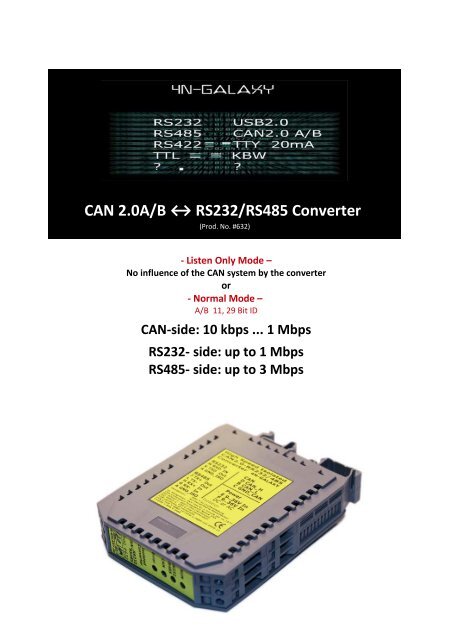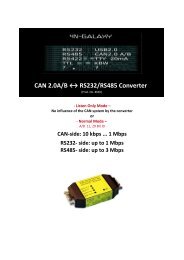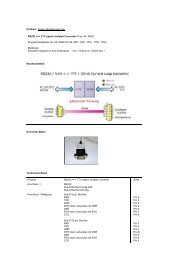CAN 2.0A/B â RS232/RS485 Converter
CAN 2.0A/B â RS232/RS485 Converter
CAN 2.0A/B â RS232/RS485 Converter
You also want an ePaper? Increase the reach of your titles
YUMPU automatically turns print PDFs into web optimized ePapers that Google loves.
<strong>CAN</strong> <strong>2.0A</strong>/B ↔ <strong>RS232</strong>/<strong>RS485</strong> <strong>Converter</strong><br />
(Prod. No. #632)<br />
- Listen Only Mode –<br />
No influence of the <strong>CAN</strong> system by the converter<br />
or<br />
- Normal Mode –<br />
A/B 11, 29 Bit ID<br />
<strong>CAN</strong>-side: 10 kbps ... 1 Mbps<br />
<strong>RS232</strong>- side: up to 1 Mbps<br />
<strong>RS485</strong>- side: up to 3 Mbps
Table of Contents<br />
Table of Contents.....................................................................................................................................2<br />
1 Introduction...........................................................................................................................................3<br />
2 Startup...................................................................................................................................................4<br />
3 <strong>Converter</strong> Block Diagram.......................................................................................................................5<br />
4 Setup Mode............................................................................................................................................5<br />
5 Normal Mode.........................................................................................................................................7<br />
6 <strong>Converter</strong> ASCII Commands...................................................................................................................9<br />
7 Technical Specifications: <strong>CAN</strong> ↔ <strong>RS232</strong>/<strong>RS485</strong> Adapter (#630)........................................................12
1 Introduction<br />
As a powerful tool the <strong>CAN</strong> converter supports development, service, testing and maintenance of<br />
<strong>CAN</strong>-based systems. They are suitable for online monitoring and manipulation of the bus as well as<br />
their logging.<br />
The converter supports 11 and 29 bit identifiers (<strong>CAN</strong><strong>2.0A</strong>/2.0B). The Listen Only mode it is no<br />
transmission of Ack bit and error frames, thereby influencing the <strong>CAN</strong> system is avoided.<br />
The <strong>CAN</strong> baud rate is detected automatically by the converter. As well the converter provides the<br />
ability to adjustthe baud rate and other parameters to your needs.<br />
The <strong>CAN</strong> <strong>Converter</strong> is ideally suitable for the investigation of the <strong>CAN</strong> bus data. The converter can be<br />
easily plugged into any <strong>RS232</strong> or <strong>RS485</strong> port of a computer or notebook. The data can be displayed<br />
in any standard terminal program or the 4N-<strong>CAN</strong>-terminal program.<br />
More information can be found in the following sections.
2 Startup<br />
Before first use:<br />
• Connect converter on <strong>RS232</strong>/<strong>RS485</strong> side with your pc <strong>RS232</strong>/<strong>RS485</strong>-port<br />
• Connect <strong>CAN</strong>-side with your application<br />
• Start the terminal program<br />
In our download area you will find the converter optimized for the terminal program: 4N-GX<br />
<strong>CAN</strong>-Terminal<br />
• Choose the right COM port<br />
• Set COM port to 38600 Baud 8N1<br />
• Power on the converter<br />
• Send within 5 seconds a "s" (initiates the setup mode)<br />
• The converter responds "<strong>CAN</strong>2.0 – <strong>RS232</strong>/<strong>RS485</strong> <strong>Converter</strong> V4.4"<br />
• Send "h" for help output in the terminal<br />
• Set <strong>CAN</strong> side configuration as needed<br />
• Send "E" - Stores settings in the flash and restarts the converter. ( - corresponds to<br />
"Enter" key)<br />
• Done<br />
Important:<br />
Sending a "s" within 5 seconds switches the converter into setup mode. Options of this mode will be<br />
described later. "E" or "Q" ends the setup mode.<br />
E - Saves Configuration to the converters flash memory, and exits the setup mod<br />
Q - Exit without saving<br />
For the operation of the converter, the following setup parameters must be set correctly:<br />
• <strong>CAN</strong> Baudrate (or Autobaud)<br />
• ID (results in 11- or 29-Bit Format)<br />
• Acceptance-Code<br />
• Acceptance-Mask<br />
• <strong>RS232</strong>/<strong>RS485</strong> Baudrate
4.1 <strong>CAN</strong> ID Filter Setup<br />
The converters accept messages from specific IDs which can be defined by the <strong>CAN</strong> identifier (CI), the<br />
<strong>CAN</strong>-Acceptance-Code (CAC) and the <strong>CAN</strong>-Acceptance-Mask (CAM). CAC defines the mandatory<br />
required bits of the received ID and the CAM, the bits to ignore. The <strong>CAN</strong> identifier<br />
can be determined by the choice of converter id to whether either will be accepted ONLY 11<br />
bits (id
4.2 <strong>CAN</strong> Modes<br />
The converter is in Listen Only mode or normal mode to operate.<br />
L = 1 Listen Only Mode (read without ACK) L = 0 Normal Mode (read and write)<br />
5 Normal Mode<br />
If the converter powered on and the setup mode is not initiated within 5 seconds, it starts in<br />
normal mode. In this mode, the communication of the <strong>CAN</strong> bus can be monitored (chapter:<br />
5.2 Receive Data) and data be transmitted to the bus (chapter: 5.1 Sending Data).<br />
5.1 Sending Data<br />
All Data, sent from the computer to the COM port, will be output on the <strong>CAN</strong> bus.<br />
The following formats are used:<br />
ID CR space = $20 (Space "_") CR = $ 0D (Enter "") - ID without Data<br />
ID space Data CR space = $20 (Space "_") CR = $ 0D (Enter "") - ID with Data<br />
With the converter setting:<br />
<strong>CAN</strong>-Identifier = 1F000000 (29 Bit <strong>CAN</strong>-Identifier)<br />
the following data is output: (11 and 29 bit messages)<br />
Input<br />
Meaning<br />
7E8_0001020304 <strong>CAN</strong> ID 7E8 Data 00 01 02 03 04 Data Length 5<br />
7E8_0 <strong>CAN</strong> ID 7E8 no Data Data Length 0<br />
7E8_01_01 <strong>CAN</strong> ID 7E8 Data 01 Data Length 1<br />
1FFFFFFF_010203_03 <strong>CAN</strong> ID 1FFFFFFF Data 0102030 Data Length 3<br />
10001234_0102_02 <strong>CAN</strong> ID 10001234 Data 01020 Data Length 2<br />
With the setting:<br />
<strong>CAN</strong>-Identifier = 1FF (11 Bit <strong>CAN</strong>-Identifier)<br />
the following data is output: (only 11 bit <strong>CAN</strong> messages)<br />
Input<br />
Meaning<br />
7E8_0001020304_05 <strong>CAN</strong> ID 7E8 Data 00 01 02 03 04 Data Length 5<br />
7E8_0 <strong>CAN</strong> ID 7E8 no Data Data Length 0<br />
7E8_01_01 <strong>CAN</strong> ID 7E8 Data 01 Data Length 1<br />
In case of 11 bit ID no 29 bit ID messages will be sent!<br />
5.1.1 Send Error<br />
If data is sent in the wrong format to the converter through the USB/COM port, it can be recognized<br />
by the converter response "S" (Enter "S" Enter).<br />
e.g.: 1FFFFFFF_010<br />
<strong>Converter</strong> response: "S"<br />
(incomplete data, 0101 would be correct)
5.2 Receiving Data<br />
What data received by the converter and at <strong>RS232</strong>/<strong>RS485</strong> side are output for further processing<br />
depends on the configuration of the <strong>CAN</strong> identifier, the CAM-Acceptance-Code and the <strong>CAN</strong>-<br />
Acceptance-Mask. A detailed description of these parameters can be found with examples in<br />
chapter "3.1 <strong>CAN</strong> ID Filter Setup".<br />
Accepted <strong>CAN</strong> messages will be output in ASCII format as followed:<br />
ID space Data space Length CR<br />
space = $20 (Space "_") CR = $ 0D (Enter "")<br />
With the converter setting:<br />
<strong>CAN</strong>-Identifier = 1F000000 (29 Bit <strong>CAN</strong>-Identifier)<br />
<strong>CAN</strong>-Acceptance-Code = 00000000 (0 receives all <strong>CAN</strong>-Frames)<br />
<strong>CAN</strong>-Acceptance-Mask = FFFFFFFF (F receives all <strong>CAN</strong>-Frames)<br />
the following data is output on the USB side: (11 and 29 bit message)<br />
PC Output<br />
Meaning<br />
7E8_0001020304_05 <strong>CAN</strong> ID 7E8 Data 00 01 02 03 04 Data Length 5<br />
7E8_0 <strong>CAN</strong> ID 7E8 no Data Data Length 0<br />
7E8_01_01 <strong>CAN</strong> ID 7E8 Data 01 Data Length 1<br />
1FFFFFFF_010203_03 <strong>CAN</strong> ID 1FFFFFFF Data 0102030 Data Length 3<br />
10001234_0102_02 <strong>CAN</strong> ID 10001234 Data 01020 Data Length 2<br />
With the setting:<br />
<strong>CAN</strong>-Identifier = 1FF (11 Bit <strong>CAN</strong>-Identifier)<br />
<strong>CAN</strong>-Acceptance-Code = 00000000 (0 receives all <strong>CAN</strong>-Frames)<br />
<strong>CAN</strong>-Acceptance-Mask = FFFFFFFF (F receives all <strong>CAN</strong>-Frames)<br />
the following data is output: (only 11 bit <strong>CAN</strong> messages)<br />
PC Output<br />
Meaning<br />
7E8_0001020304_05 <strong>CAN</strong> ID 7E8 Data 00 01 02 03 04 Data Length 5<br />
7E8_0 <strong>CAN</strong> ID 7E8 no Data Data Length 0<br />
7E8_01_01 <strong>CAN</strong> ID 7E8 Data 01 Data Length 1<br />
5.2.1 Receive Error<br />
Error LED (Buffer Overflow LED) lights up, if data is sent to fast from the PC to the converter.<br />
Buffer Overflow can be recognized by "E" (Enter "E" Enter).<br />
"E" is send from converter to PC.<br />
At full <strong>CAN</strong> bus utilization can rarely cause errors (at 1 Mbps 100% bus utilization).<br />
To recognize this is the fact that the messages are not received in full.<br />
z.B.<br />
7E8_000102 <strong>CAN</strong> ID 7E8 Data 00 01 02 ? Data Length?<br />
7E8_01 <strong>CAN</strong> ID 7E8 Data 01 ? Data Length?
6 <strong>Converter</strong> ASCII Commands<br />
(CR)=Enter (Dez=13, Hex=0D)<br />
Es können Klein- und Großbuchstaben verwendet werden.<br />
Befehl<br />
Funktion<br />
S S Setup-Mode activation<br />
P<br />
C<br />
P0(CR)<br />
P1(CR)<br />
C0(CR)<br />
C1(CR)<br />
C2(CR)<br />
C3(CR)<br />
C4(CR)<br />
C5(CR)<br />
C6(CR)<br />
C7(CR)<br />
C8(CR)<br />
C9(CR)<br />
CA(CR)<br />
CB(CR)<br />
CC(CR)<br />
CD(CR)<br />
CE(CR)<br />
CF(CR)<br />
Is possible only after power up in the first 5 seconds! In setup mode,<br />
settings for the <strong>CAN</strong> side can be made and stored.<br />
Shows settings stored in converter RAM – changes have to be saved<br />
by "E" xit<br />
Show default settings.<br />
Response: “Settings: List(CR)OK(CR)“ or “ERROR(CR)“<br />
e.g.<br />
C <strong>CAN</strong>-Bitrate : 5<br />
L <strong>CAN</strong>-Mode : 0<br />
I <strong>CAN</strong>-Identifier : 10000000<br />
A <strong>CAN</strong>-Acceptance-Code : 00000100<br />
M <strong>CAN</strong>-Acceptance-Mask : 00000000<br />
R Baudrate : 3<br />
Identifier Length : 29<br />
Acc. Code Length : 32<br />
Acc. Mask Length : 32<br />
OK<br />
10 kbps <strong>CAN</strong> Bitrate<br />
20 kbps <strong>CAN</strong> Bitrate<br />
25 kbps <strong>CAN</strong> Bitrate<br />
50 kbps <strong>CAN</strong> Bitrate<br />
62,5 kb <strong>CAN</strong> Bitrate<br />
100 kbps <strong>CAN</strong> Bitrate<br />
125 kbps <strong>CAN</strong> Bitrate<br />
128,2 kb <strong>CAN</strong> Bitrate<br />
192 kbps <strong>CAN</strong> Bitrate<br />
250 kbps <strong>CAN</strong> Bitrate<br />
500 kbps <strong>CAN</strong> Bitrate<br />
800 kbps <strong>CAN</strong> Bitrate<br />
1.0 Mbps <strong>CAN</strong> Bitrate Other baud rates available on request<br />
Autobaud – automatic baudrate Detection<br />
Autobaud – automatic baudrate Detection<br />
Autobaud – automatic baudrate Detection<br />
Response: “Settings: List(CR)OK(CR)“ or “ERROR(CR)“
Befehl<br />
I<br />
Ixxx(CR)<br />
or<br />
Ixxxxxxxx(CR)<br />
Funktion<br />
Identifier in Hex (000...7FF)<br />
11 Bit Standard Format<br />
or<br />
Identifier in Hex (00000000...1FFFFFFF) 29 Bit Extended Format<br />
L Lx(CR) Listen Mode Only (0...1)<br />
This setting determines whether only 11-bit or 11-bit and 29-bit are<br />
accepted by <strong>CAN</strong>-Acceptance-Code and <strong>CAN</strong>-Acceptance-Mask.<br />
Response: “List of parameters: (CR)OK(CR)” or “ERROR(CR)“<br />
0 – <strong>CAN</strong> Normal Mode (read and write)<br />
1 – <strong>CAN</strong> Listen Only Mode (listening only, read)<br />
Response: “List of parameters: (CR)OK(CR)” or “ERROR(CR)“<br />
A Axxxxxxxx(CR) <strong>CAN</strong>-Acceptance-Code x = (0...000007FF) 11 Bit Standard Format<br />
<strong>CAN</strong>-Acceptance-Code x = (0...1FFFFFFF) 29 Bit Extended Format<br />
x = 0 receives all <strong>CAN</strong>-Frames<br />
Response: “List of parameters: (CR)OK(CR)” or “ERROR(CR)“<br />
M Mxxxxxxxx(CR) <strong>CAN</strong>-Acceptance-Mask x = (0..000007FF) 11 Bit Standard Format<br />
<strong>CAN</strong>-Acceptance-Mask x = (0..1FFFFFFF) 29 Bit Extended Format<br />
R<br />
V<br />
N<br />
R0(CR)<br />
R1(CR)<br />
R2(CR)<br />
R3(CR)<br />
R4(CR)<br />
R5(CR)<br />
R6(CR)<br />
R7(CR)<br />
R8(CR)<br />
R9(CR)<br />
RA(CR)<br />
RB(CR)<br />
RC(CR)<br />
RD(CR)<br />
RE(CR)<br />
RF(CR)<br />
x = F receives all <strong>CAN</strong>-Frames<br />
Response: “List of parameters: (CR)OK(CR)” or “ERROR(CR)“<br />
600 bps <strong>RS232</strong>/<strong>RS485</strong> Baudrate (all 8 N 1)<br />
1200 bps<br />
2400 bps<br />
4800 bps<br />
9600 bps<br />
19200 bps<br />
38400 bps<br />
57600 bps<br />
115200 bps<br />
230000 bps<br />
500000 bps<br />
600000 bps<br />
750000 bps<br />
1000000 bps<br />
1500000 bps<br />
3000000 bps Other baud rates available on request<br />
Response: “ (CR)OK(CR)” or “ERROR(CR)”<br />
Software Version Number<br />
Response: „Software Version: x.x(CR)“<br />
<strong>Converter</strong> Nummer<br />
x = 0..F<br />
Response: „<strong>Converter</strong>-ID: xxxx xxxx(CR)“ x= 0..F
Befehl<br />
?<br />
or<br />
H<br />
?<br />
or<br />
H<br />
Funktion<br />
Help<br />
This table is output to the COM port<br />
E E Exit<br />
Exits the Setup Mode and saves the configuration in flash memory of the<br />
converter, followed by a Reset = Power On(Restart)<br />
Response: e.g.<br />
C <strong>CAN</strong>-Bitrate : 5<br />
L <strong>CAN</strong>-Data Length : 8<br />
I <strong>CAN</strong>-Identifier : 1F0000000<br />
A <strong>CAN</strong>-Acceptance-Code : 00000100<br />
M <strong>CAN</strong>-Acceptance-Mask : 00000000<br />
R USB-Baudrate : 3<br />
Identifier Length : 29<br />
Acc. Code Length : 32<br />
Acc. Mask Length : 32<br />
SAVE to EEprom<br />
OK<br />
RESET<br />
Q Q Quit<br />
Exits the setup mode WITHOUT saving changes in the in flash memory of<br />
the converter, followed by a Reset = Power On(Restart)<br />
Response:<br />
OK<br />
RESET<br />
Other parameters, functions are available on request.
7 Technical Specifications: <strong>CAN</strong> ↔ <strong>RS232</strong>/<strong>RS485</strong> Modul (#632)<br />
Product: <strong>CAN</strong>2.0 <strong>RS232</strong> & <strong>RS485</strong> High Speed Isolated Modul #632<br />
PC Software:<br />
PC Software Docu:<br />
Connector 1:<br />
Connector 1 Pins:<br />
Terminator:<br />
4N-GX <strong>CAN</strong>-Terminal<br />
4N-GX <strong>CAN</strong>-Terminal-v2.05-germany<br />
4N-GX <strong>CAN</strong>-Terminal-v2.05-english<br />
<strong>CAN</strong> <strong>2.0A</strong>/B:<br />
High speed vollisolierter <strong>CAN</strong> <strong>2.0A</strong> & 2.0B Bus<br />
Slope-Control Mode to Reduce EMI<br />
Thermal Shutdown, Current Limiting<br />
ISO 11898 Standard, <strong>CAN</strong> <strong>2.0A</strong> & 2.0B<br />
Klemme B - <strong>CAN</strong>_L<br />
Klemme D - <strong>CAN</strong>_H<br />
Klemme C - GND_<strong>CAN</strong><br />
120 R - between <strong>CAN</strong>_L and <strong>CAN</strong>_H (intern)<br />
<strong>CAN</strong> 2.0 baudrates: 10 Kbps<br />
20 Kbps<br />
25 Kbps<br />
50 Kbps<br />
62,5 Kbps<br />
100 Kbps<br />
125 Kbps<br />
250 Kbps<br />
500 Kbps<br />
800 Kbps<br />
1.0 Mbps<br />
oder<br />
Autobaud<br />
Connector 2:<br />
<strong>RS232</strong>:<br />
±15 kV Human Body Model<br />
±8 kV IEC 1000-4-2, Contact Discharge<br />
±15 kV IEC 1000-4-2, Air-Gap Discharge<br />
Latchup Free<br />
1 Mbps Data Rate<br />
EIA/TIA-232 Specifications Down to 3.0 V<br />
<strong>RS485</strong> Receiver:<br />
+/- 15 kV Human Body Model<br />
+/- 6 kV IEC 1000-4-2, Contact Discharge<br />
+/- 12 kV IEC 1000-4-2, Air-Gap Discharge<br />
Allow Up to 128 Receivers on the Bus
True-Fail-Safe Receiver<br />
-7V .. +12V Common-Mode Range<br />
Thermal Protection Against Output Short Circuit<br />
<strong>RS485</strong> Driver:<br />
+/- 9 kV Human Body Model<br />
Slev-Rate Limited for Errorless Data Transmission<br />
-7V .. +12V Common-Mode Range<br />
Current Limiting<br />
Thermal Shutdown for Driver-Overload Protection<br />
Connectron 2 Pins:<br />
<strong>RS232</strong>:<br />
Klemme M - RXD In<br />
Klemme K - TXD Out<br />
Klemme A - GND_RS<br />
<strong>RS485</strong>:<br />
Klemme J - TX+ Out<br />
Klemme L - TX- Out<br />
Klemme H - RX+ In<br />
Klemme G - RX- In<br />
Klemme A - GND_RS<br />
Connector 3:<br />
Connector 3 Pins:<br />
<strong>RS232</strong> & <strong>RS485</strong><br />
baudrates:<br />
Power In<br />
Power In:<br />
Klemme E - 9..36V DC oder AC Input<br />
Klemme F - 9..36V DC oder AC Input<br />
600 bps (all 8 N 1)<br />
1200 bps<br />
2400 bps<br />
4800 bps<br />
9600 bps<br />
19200 bps<br />
38400 bps<br />
57600 bps<br />
115200 bps<br />
230000 bps<br />
500000 bps<br />
600000 bps<br />
750000 bps<br />
1000000 bps<br />
1500000 bps<br />
3000000 bps<br />
<strong>RS232</strong> up to 1 Mbps, <strong>RS485</strong> up to 3 Mbps<br />
Galvanic isolation:<br />
High common-mode transient immunity: >25 kV/µs<br />
Safety and regulatory approvals
UL recognition: 5000 V rms for 1 minute per UL 1577<br />
CSA Component Acceptance Notice #5A<br />
IEC 60950-1: 600 V rms (reinforced)<br />
IEC 60601-1: 250 V rms (reinforced)<br />
VDE certificate of conformity<br />
DIN V VDE V 0884-10 (VDE V 0884-10):2006-12<br />
VIORM = 846 V peak<br />
Indicators:<br />
Poerating tmperatur:<br />
Dimensions<br />
Run LED<br />
<strong>CAN</strong> LED<br />
<strong>RS232</strong>/<strong>RS485</strong> LED<br />
Buffer Overflow LED<br />
-5..+70°C<br />
(mm) 90 x H 75 x B 23 for Rail Din






